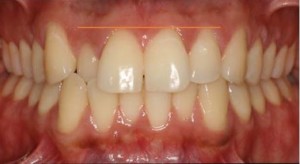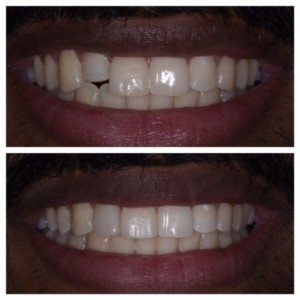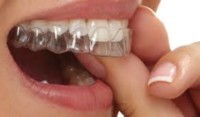Clear aligners: what role do they play in cosmetic dental treatment?

Please observe the above picture. Notice that the second upper tooth to the patient’s right, the lateral incisor, is positioned behind the lower teeth, in “crossbite”. I drew an orange line showing the gum levels of the two middle teeth, the central incisors. Ideally the gum levels of the second teeth are just below that line, but you can see that the lateral on the patient’s left is on the line and the one on the patient’s right is far below it. In addition, the right lateral has experienced significant wear because of its position behind the lower teeth. The patient wanted clear aligners to correct the crossbite. During the pretreatment consultation we discussed the relative shortness of the right lateral as compared to the left. If we were to align the teeth and properly position the biting edges, the gum levels would be at different heights. Humans are wired to detect asymmetry, and we tend to dislike it. When I discussed the option of positioning the teeth for ideal gum levels and then having the dentist “bond” the right lateral to proper length, the patient expressed a preference for symmetry and so selected that plan. Clear aligners, such as Invisalign, are capable of achieving such vertical re-positioning of the teeth.
The link between clear aligners and cosmetic bonding.
Once the patient has progressed through the series of clear aligners, the restoring dentist takes inspects tooth position and either confirms ideal placement or requests further movement. Once it has been determined that ideal tooth movement has been accomplished, appointments are coordinated so that the dentist performs the cosmetic bonding and then the patient returns to the orthodontist for retainer impressions.

In the above view, you can see that the right lateral incisor was “intruded” for proper gum position. When the dentist added length and ideal shape with bonding, symmetry was achieved with respect to tooth length, tooth width, and gum levels. The same holds for other dental procedures, such as crowns or ceramic veneers. If the short right lateral was positioned lower so the biting edge was in the correct position without bonding, then the gum level would be too low and it would be far less attractive. Ideally, a lateral incisor’s width is 70-80% of its height, and that was achieved by intruding and then lengthening the worn lateral. In addition, the left lateral was moved down a bit, allowing for an ideally-positioned biting edge, just slightly higher than the edges of the central incisors.
Finally, if you are interested in learning more about how gum levels affect smile esthetics, check this link: http://www.scielo.br/pdf/dpjo/v17n5/25.pdf.


